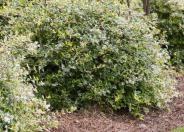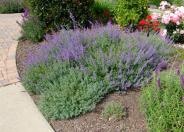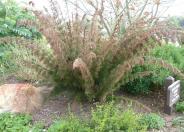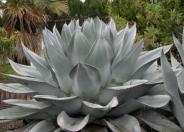
Common name:Miss Lemon Abelia
Botanical name:Abelia X gra. 'Miss Lemon'
An outstanding Abelia with bright variegated foliage that starts yellow with green centers when young, then matures to ivory and green. Produces a heavy bloom of white flowers for summer and fall.

Common name:Oriental Fountain Grass
Botanical name:Pennisetum orientale
Oriental Fountain Grass is a clumping warm-season grass with spectacular pink flowers.

Common name:Dropmore Catmint
Botanical name:Nepeta X faassenii 'Dropmore'
Dropmore Catmint has soft, grey-green, fragrant foliage that reaches 1'-3' tall, spreading 3'-4' wide. The small leaves are not attractive to cats but bees and butterflies love this plant. This perennial has lavender blue flowers from spring through fall (may depend on heat). Catmint can be planted in sun or part shade in warm inland valleys with well draining, sandy, dry soil. It tolerates coastal conditions. It is drought tolerant once it's established. Prune spent flowers to encourage more blooms. Flowers are fragrant and great for flower arrangements. It is deer and rabbit resistant.

Common name:Sunshine Ligustrum
Botanical name:Ligustrum sinense 'Sunshine'
Sunshine Ligustrum is a hybrized Ligustrum with charteuse colored leaves. It grows to about 6 ft. in height and 3-4 ft. wide. It makes a great short hedge, an accent, topiary, border or container plant. Incredible color accent since its golden foliage looks great year round. It does best in full to part sun with well draining soil. Established plants need moderate amount of water. This evergreen shrub can use fertilizer in the spring. Doesn't need pruning unless you want to shape it your way!

Common name:Horsetail Restio
Botanical name:Elegia capensis
This attractive perennial resembles a grass gone wild. Stalks reach 6'-8' tall, with even spacing of long feathery branches and paper-like bracts. Plants can spread 7' wide. Clusters of small brown flowers appear above foliage in fall and winter. This plant needs constant moisture and well draining soil in full or part sun. It is dramatic when moving in the wind.

Common name:Whale's Tongue Agave
Botanical name:Agave ovatifolia
This versatile Agave is a solitary plant, growing quite large, with rosettes that can reach 7' across. Leaves are grayish white color with small marginal teeth. The leaf blade is short, wide and distinctively cupped, thus the common name, Whale's Tongue. This Agave looks great in a pot on a patio, under trees, with large boulders or planted with other succulents. It can take intense heat and cold. It grows moderately fast but prefers well drained soil.

Common name:Mundi Rosemary
Botanical name:Westringia fruticosa 'Mundi'
A great groundcover form of coastal rosemary. Used as a specimen or in mass, Mundi is great for tough roadsides and residential gardens alike. Best suited to Zones 9-11 in arid climates although Mundi continues to show potential for low water gardens in humid regions. Mundi's super short height and infrequent pruning requirement distinguish it from other Westringia currently on the market. Coastal rosemary, so named for its rosemary-like leaves, is a drought and salt tolerant shrub that works well in coastal plantings. Some Westringia varieties, including Mundi, are also proving to be adapt to humid, subtropical climates of the southeastern US. So while Westringia are best suited to Mediterranean climates. Established plants quickly grow to 1-2 feet tall and 4-6 feet wide. It can tolerate full sun in coastal areas but afternoon shade in warm inland areas. Small white flowers dot the plant from winter to late spring but may bloom year round in coastal areas.
Designer: Susan Morrison
Photographer: Vicki Anderson
Physical weed control, including mulching, or hand removal protects the watershed from harmful chemicals.
Drip and other smart irrigation delivers water directly to roots, allowing no excess water for weeds.